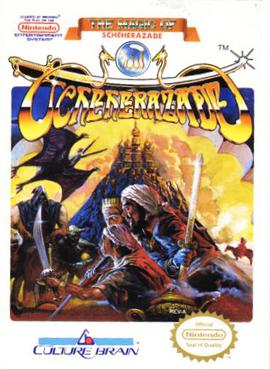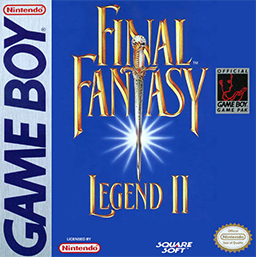
EarthBound, released in Japan as Mother 2: Gīgu no Gyakushū, is a role-playing video game developed by Ape Inc. and HAL Laboratory and published by Nintendo for the Super Nintendo Entertainment System. The second entry in the Mother series, it was first released in Japan in August 1994, and in North America in June 1995. A port for the Game Boy Advance developed by Pax Softnica, bundled with Mother (1989) as Mother 1+2, was released only in Japan in 2003. The game focuses on Ness and his party of Paula, Jeff and Poo, as they travel the world to collect melodies from eight Sanctuaries in order to defeat the universal cosmic destroyer Giygas.

Huang Zhong, courtesy name Hansheng, was a Chinese military general serving under the warlord Liu Bei during the late Eastern Han dynasty of China. He is best known for his victory at the Battle of Mount Dingjun in 219, in which his force routed that of an enemy general, Xiahou Yuan, who was killed in action during the raid.

Terranigma is a 1995 action role-playing game developed by Quintet for the Super Nintendo Entertainment System (SNES), with manga artist Kamui Fujiwara acting as the character designer. The game tells the story of the Earth's resurrection by the hands of a boy named Ark, and its progress from the evolution of life to the present day. The game is considered the third and final entry in an unofficial trilogy of action RPGs created by Quintet, also including Soul Blazer (1992) and Illusion of Gaia (1993).

Dynasty Warriors 4 is a hack and slash video game and the fourth installment in the Dynasty Warriors series. Dynasty Warriors 4 was developed by Omega Force and published by Koei. The game is available on PlayStation 2 (PS2) and Xbox and is based on a series of books called Romance of the Three Kingdoms, written by Luo Guanzhong. As the series has progressed, it has strayed further from the actual plot of Romance of the Three Kingdoms but instead has given the user more input on how the storyline progresses. When it was released in Japan as Shin Sangokumusou 3, it topped the sales charts, sold over one million copies within nine days, and received an average of 78 out of 100 on Metacritics reviews.

The Magic of Scheherazade is an action-adventure/role-playing video game (RPG) developed and released by Culture Brain for the Nintendo Entertainment System (NES). The game was released in 1987 in Japan and 1990 in North America. The plot is based on Middle Eastern folktales found in One Thousand and One Nights. It involves an amnesic hero traveling through time in an attempt to rescue the princess Scheherazade from the evil wizard Sabaron, who has summoned a horde of demons to bring chaos to the once peaceful land of Arabia. The Magic of Scheherazade is divided into chapters and incorporates elements of both action-adventure and RPG gameplay styles. In each chapter, the player character can freely explore an overworld in a top-down perspective. The player engages hostile enemies with various weapons and spells through both real-time solo action on the overhead map and random, turn-based battles fought alongside befriended allies.

Mega Man X: Command Mission, known in Japan as Rockman X: Command Mission (ロックマンXコマンドミッション), is a 2004 role-playing video game developed by Capcom for the PlayStation 2 and GameCube. The game is a spin-off of the Mega Man X franchise. It was released in Japan on July 29, 2004, with releases in North America and PAL regions following in September and November.

U.N. Squadron is a 1989 side-scrolling shooting game released by Capcom for the CPS arcade hardware and for the Super Nintendo Entertainment System. The game was released in Japan as Area 88, and is based on the manga series of the same name, featuring the same main characters. Their mission is to stop a terrorist group known as Project 4. It was followed by a spiritual successor Carrier Air Wing.

Final Fantasy Legend II, known in Japan as SaGa 2: Hihou Densetsu, is a role-playing video game developed and published by Square for the Game Boy. The second entry in the SaGa series, it was released in 1990 in Japan, and in 1991 in North America. A remake for the Nintendo DS was released in 2009 by Square Enix, remaining exclusive to Japan. The Game Boy version was later ported to the Nintendo Switch and released worldwide by Square Enix in 2020, with later ports to Android, iOS and Microsoft Windows in 2021.

Warriors of Fate, known in Japan as Tenchi wo Kurau 2: Sekiheki no Tatakai, is a side-scrolling beat-'em-up game produced by Capcom. It is the second arcade game based on the Tenchi wo Kurau manga, following Dynasty Wars. Originally released to arcades in 1992, home versions of the Sega Saturn and PlayStation were released in 1996. A version for mobile phones followed in 2005. Capcom later included an emulated version of the arcade original as part of the Capcom Beat 'Em Up Bundle released digitally for the Nintendo Switch, PlayStation 4, Xbox One, and Windows in September 2018.

Tenchi wo Kurau II: Shokatsu Kōmei Den is a role-playing video game released in Japan by Capcom for the Famicom in 1991. It is the sequel to Destiny of an Emperor, originally based upon the manga Tenchi wo Kurau by Hiroshi Motomiya.

Kessen II is a strategy game loosely based on the Three Kingdoms period of China. It is the sequel to Kessen in name only; both Kessen and the later sequel Kessen III are based on events in Japan and China. The gameplay involves playing out major battles as the storyline progresses, with cutscenes between each battle for the development of the events and major characters. Before battle, players are given a choice of strategies to take, although they can manually control all units in the battlefield. All units are controlled by the AI unless the player directly intervenes, and battles between forces are carried out in real-time. While in control of a unit, players are able to use special skills or magic spells to turn the tables, although enemy characters are also able to do so.

Dynasty Wars, released in Japan as Tenchi wo Kurau, is a 1989 side-scrolling beat-'em-up game released for arcades by Capcom, based on the Japanese manga Tenchi wo Kurau and a reenactment of the battle between the Kingdom of Shu and the Yellow Turban rebels. Each of the two players can assume the roles of one of the four Chinese generals riding on horseback from the Three Kingdoms period in an attempt to smash the rebellion. A sequel, Warriors of Fate, was released in 1992.
Hiroshi Motomiya is a Japanese manga artist from Chiba Prefecture. His works include Tenchi wo Kurau (1983–1984) and Salary Man Kintaro (1994–2002).

Tenchi wo Kurau is a Japanese manga series by Hiroshi Motomiya. The storyline is set in the Three Kingdoms period, when Western Shu, Northern Wei and Eastern Wu battled to conquer all of China.

Shin Megami Tensei: Devil Survivor is a 2009 tactical role-playing game developed and published by Atlus for the Nintendo DS. It is a spin-off within the wider Megami Tensei series. An expanded version subtitled Overclocked was released on the Nintendo 3DS in Japan and North America by Atlus in 2011, and in Europe by Ghostlight in 2013. Following a group of teenagers in Tokyo who are trapped inside a government lockdown following an invasion of demons, the gameplay is divided between story events tied to an in-game clock, and tactical grid-based combat with a turn-based battle system. Which events and battles are completed can unlock different endings.

Dynasty Warriors: Godseekers is a tactical role-playing game developed by Omega Force and published by Koei Tecmo. The game is a spinoff to the Dynasty Warriors series of video games that focuses less on action, and more strategy, similar to prior spinoff Dynasty Tactics. The game was released on the PlayStation Vita and PlayStation 4 video game consoles in the West, with a PlayStation 3 port existing only in Japan.

Wo Long: Fallen Dynasty is a historical fantasy action role-playing video game developed by Team Ninja and published by Koei Tecmo. The game was released on March 3, 2023 on PlayStation 4, PlayStation 5, Windows, Xbox One and Xbox Series X/S.
Tenchi wo Kurau II may refer to:















